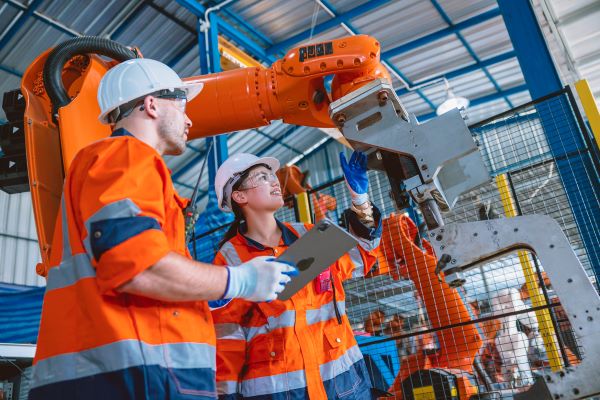In light of wide-scale geopolitical instability, the tariff wars and the unprecedented supply chain disruptions of the last few years, many US manufacturers are coming to the conclusion that offshore production is simply not a viable option going forward.
Reshoring is happening at scale
In response, many are looking toward reshoring as a way to increase supply chain resilience and mitigate risk. According to the latest Kearney Annual Reshoring Index survey, 96% of American CEOs plan to initiate reshoring as a strategy to bolster supply chain resilience this year – 18% more than in 2022. Another report showed that 364,000 manufacturing jobs returned to the US in 2022 alone – a 55% increase from the year before.
So, what does this mean for US manufacturing in practical terms? For one thing, it means training.
The reshoring trend is running parallel to one of the greatest skills shortages we’ve seen in the history of US manufacturing. The current talent shortage, if left unchecked, is going to cost the US economy $1 trillion in 2030, according to Deloitte. If the reshoring trend fulfills its promise to generate or return hundreds of thousands of jobs to US soil, as many reshoring advocates are asserting, then we need to get to work attracting talent and equipping them with the skills they need to perform, while making sure we’re retaining the people we have already.
And this is all going to be done at scale.
Major upgrade to manufacturing training
It’s a huge job. How are we going to get it done? In my opinion, the project has three primary dimensions, all of which require a major upgrade to the ways we currently approach training in manufacturing.
First, we need to attract the right people.
We have to remember that the New Manufacturing Workforce is comprised primarily of younger generations – mostly Millennials and GenZ – and they have a totally different relationship with technology.
Millennials want the best tech
71% of Millennials we recently surveyed said that the degree to which an organization embraces technology and innovation has a direct impact on their decision to work there. 61% said they wanted to use their smartphone at work. They grew up with technology as a major part of their everyday lives, and they want to work as they live: plugged in, digitally enabled, using technology to simplify and streamline their workflows and training experiences. If manufacturers hope to attract top talent, they need to make sure they’re delivering in this regard, particularly when it comes to training materials and approaches, and the work instructions and product content workers are using every day.
Once we’ve attracted the right people, we need to train them up, and we’re going to have to do this fast, and at scale. Traditional training methods (PowerPoint-driven classroom environments, flat training materials, PDF manuals and SOPs) are not up to the task. They’re slow and inefficient. They don’t take into account varied learning modalities, which is an important consideration with this new generation of workers, and they deliver low levels of retention. They disadvantage second-language English speakers and neurodivergent workers. They lead to poor levels of comprehension, errors, and poor performance. In short, they set new workers up to fail.
Shocking quality
Manufacturers urgently need to upgrade their training materials. Which do you think would help you understand a complex mechanism faster? A grainy, over-photocopied 2-D diagram, or a digitized, interactive, animated 3D product model which the learner can rotate, zoom into, pull out of, pull apart and put back together? I think it’s a no-brainer, but you’d be shocked at the quality of training materials we see - even in major manufacturing operations.
Lastly, once we’ve attracted and trained the right people, we need to keep them. We do this by empowering them with the high-quality product content and work instructions they need to perform well in their positions, and by investing in their ongoing professional development. 80% of Millennials said that on-the-job training, continued professional development and formal training were critical in helping them to perform at their best, and being made to feel like their development is an organizational priority is one of the top reasons Millennials stay with a company, according to Deloitte. Creating a culture of growth, learning and development supported by effective, efficient training strategies is mission-critical to keeping your top people in place.
Major sea change
If the reshoring trend continues, the manufacturing industry has a major training job ahead of it, and traditional training materials, product content and flat work instructions are not up to the job. It’s time manufacturers began to prepare for a major sea change in the industry. To start, we need to focus on the quality of the materials we’re using to train our people.
A move to interactive digital work instructions is really the low-hanging fruit here. It’s a moderate investment that will deliver major returns, not only allowing for training at scale, but also setting new workers up to succeed.
Because folks, we’ve got our work cut out for us.
Do you think reshoring will be a major reality in the near future? If not, why not?



